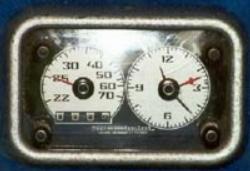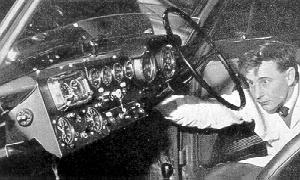The MGA With An Attitude
Rally Computer, HALDA SPEEDPILOT - COMP-203B
The Magic Box - Halda Speed-Pilot
From MOTOR RALLY - March 1956 (Supplement to MOTOR RACING)
MAGIC BOX
Average speed computer on test
A few days before the start of the Monte Carlo Rally there were references in the National daily press to a "magic box" fitted to the Sunbeam team cars. This "magic box'' was said to eliminate the need for rapid brain calculations to navigators in maintaining set average speeds. Over the past few weeks we have tested this mechanical brain and have found it not only efficient but also a fascinating accessory for ordinary motoring. Average speed computers are not new, we know of at least three examples which have been available for the last year or so but they have been out or reach of most private owner rallyists and moreover, their accuracy and reliability was not always or the highest order. The Halda "Speed-Pilot" is designed and made by an old established firm of taximeter manufacturers in Sweden.
 The "box" consists of two dials side by side in a rectangular glass fronted metal case. On the left hand dial, graduated from 22 to 75 mph, the desired average speed is set. A trip-meter reads to one-hundredth of a mile. The right hand dial is an eight day clockwork chronometer with a bright red third hand. Four control knobs, one in each corner, are for setting the desired speed, operating the trip-meter and the chronometer pointer, and the fourth is for winding and setting the hands or the chronometer. The unit is internally lit, wired in parallel with the usual instrument lighting switch. The computer is driven by cable through a "T" gearbox which forms an extension to the speedometer cable. It is only necessary to know the number of revolutions per mile of the speedometer cable - a figure usually given on the face of the speedometer, to set the computer. The purpose of an average speed computer is to display readily the accuracy with which predesired average speeds are being kept. For example, to average 30 mph the speed pointer is set to the figure 30 on the left hand dial, the red pointer and the minute hand on the chronometer are aligned with each other. If an average of 30 mph is maintained the red hand rotates at the same speed as the minute hand, but if the average is less the red hand falls behind or if too high the red pointer gains on the minute hand. Therefore at any time the exact number of minutes ahead or behind average can be read.
The "box" consists of two dials side by side in a rectangular glass fronted metal case. On the left hand dial, graduated from 22 to 75 mph, the desired average speed is set. A trip-meter reads to one-hundredth of a mile. The right hand dial is an eight day clockwork chronometer with a bright red third hand. Four control knobs, one in each corner, are for setting the desired speed, operating the trip-meter and the chronometer pointer, and the fourth is for winding and setting the hands or the chronometer. The unit is internally lit, wired in parallel with the usual instrument lighting switch. The computer is driven by cable through a "T" gearbox which forms an extension to the speedometer cable. It is only necessary to know the number of revolutions per mile of the speedometer cable - a figure usually given on the face of the speedometer, to set the computer. The purpose of an average speed computer is to display readily the accuracy with which predesired average speeds are being kept. For example, to average 30 mph the speed pointer is set to the figure 30 on the left hand dial, the red pointer and the minute hand on the chronometer are aligned with each other. If an average of 30 mph is maintained the red hand rotates at the same speed as the minute hand, but if the average is less the red hand falls behind or if too high the red pointer gains on the minute hand. Therefore at any time the exact number of minutes ahead or behind average can be read.
 For the purpose of our test the "Speed-Pilot" was fitted by the Halda company in a matter of an hour or so, to a new Lancia Aurelia which we were to drive in a short Sunday afternoon navigational rally. In this particular event there was no Regularity Test, but the "Speed- Pilot" was most useful for ensuring that we were not late or early at controls. The first part of the rally consisted of a road section 11.8 miles long to be covered in 28 minutes. The minimum average speed was therefore 25.3 mph. In that time we had to visit points en route at which various questions were to be answered.
For the purpose of our test the "Speed-Pilot" was fitted by the Halda company in a matter of an hour or so, to a new Lancia Aurelia which we were to drive in a short Sunday afternoon navigational rally. In this particular event there was no Regularity Test, but the "Speed- Pilot" was most useful for ensuring that we were not late or early at controls. The first part of the rally consisted of a road section 11.8 miles long to be covered in 28 minutes. The minimum average speed was therefore 25.3 mph. In that time we had to visit points en route at which various questions were to be answered.
To be on the safe side we set the speed pointer at 26 mph, the clock was synchronized with that of the organizers and the red hand set at our starting time of 22 minutes past the hour. We then knew that we had until 50 minutes past the hour to reach control, and that if the red pointer did not fall behind the minute hand of the chronometer we could not fail to be on time. We arrived with two minutes in hand.
We decided to transfer the "Speed-Pilot" from the Lancia to an Austin A30 Countryman, to satisfy ourselves that the job could be done by an average private owner. It took but ten minutes to disconnect the "T" drive, reconnect the cable and undo the two nuts and bolts holding the computer to the Lancia instrument panel. We then ensured that the ''Speed-Pilot'' was geared correctly for the A30 by turning a screw which is visible through a small hole in the bottom of the instrument box, through a given number of turns either clockwise or anti-clockwise, denoted as positive or negative. The speedometer on the Lancia Aurelia was geared to 1600 revs per mile, and in accordance with a table supplied with each instrument, it was adjusted 43.7 turns towards negative. The A30 Countryman speedometer is geared at 1040 revs per mile and the table showed that the adjusting screw should be 13.5 times towards negative. It was a simple job making 30.2 turns towards positive.
From Halda we obtained a special short cable to fit between the speedometer and the "T" drive, since there is no room on the A30 to fit the ''T'' drive between the speedometer and the bulkhead. We also had to file a larger hole in the bulkhead to get the union nut on the cable through to the speedometer. The "Speed-Pilot" itself was bolted in a convenient position beneath the parcel tray.
We have used the "Speed-Pilot" for many journeys recently and there is no doubt that it adds considerably to the enjoyment. It can be just as valuable to the traveling business man or tourist as it is to the rallyeist. On a trip to the West country to keep an appointment for 11:30 am we left London at 8:30. A quick calculation showed that we had to average 32 mph over 95 miles to be on time, so we set the "Speed-Pilot" to 35 mph. During the journey it was convenient to know just how much time we had in hand for the odd cup of coffee. When we reached our destination the red pointer was exactly in line with the minute hand and we had seventeen minutes to spare.
In use the "Speed-Pilot" is almost silent, the only sounds are the quiet tick of the chronometer and a regular clicking' as the trip-meter revolves. It appears to be completely reliable.
We understand that the Halda "Speed-Pilot" although scarce at the moment, will soon be available in larger quantities. The makers are HALDEX AB, Halmstad, Sweden, and the address of the British company is Halda Ltd, 4 Brandon Road, York Way, London, N7. Agents all over the country will be available for servicing the instruments.
|